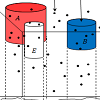Determining the optimal spatial and temporal thresholds that maximize the predictive accuracy of the prospective space-time scan statistic (PSTSS) hotspot method
Keywords:
objective function, spatial and temporal thresholds, scan statistics, predictive policing, crime hotspots, repeat victimisationAbstract
The spatial and temporal thresholds (K and T) are two key parameters that control the performance of the prospective space-time scan statistical (PSTSS) hotspot method. This study proposes an objective function approach, in which the optimal values of K and T that maximize the mean hit rate (a measure of predictive accuracy), are determined. The proposed approach involves sweeping through a range of values defined for each parameter and monitors their impacts on the mean hit rate. A case study of the crime data sets of the South Chicago area is presented in which 100 one-day consecutive predictions are carried out. Two aspects of the derived results are significant. First, is that there is a trade-off between the predictive accuracy obtainable from the use of PSTSS and the level of hotspot coverage. Second, is that K is found to have more influence on the accuracy than T. As K increases in size, the accuracy level decreases, whereas there is no notable impact of T on the accuracy, particularly when T is 30 days or more. This study also demonstrated the distinctiveness of PSTSS as a hotspot method as compared to other conventional hotspot methods. Lastly, it is argued that the approach demonstrated in this study is not only applicable to crime hotspot prediction, but could also be used in many other domains where the PSTSS technique is used.

Downloads
Published
Issue
Section
License
Copyright (c) 2018 Monsuru Adepeju, Andrew Evans

This work is licensed under a Creative Commons Attribution 4.0 International License.
Articles in JOSIS are licensed under a Creative Commons Attribution 3.0 License.
